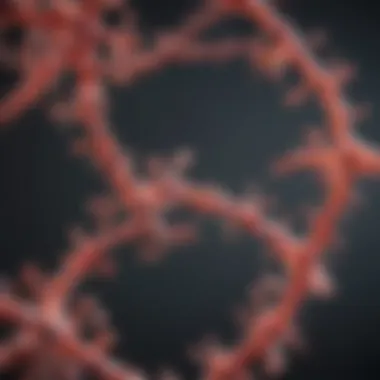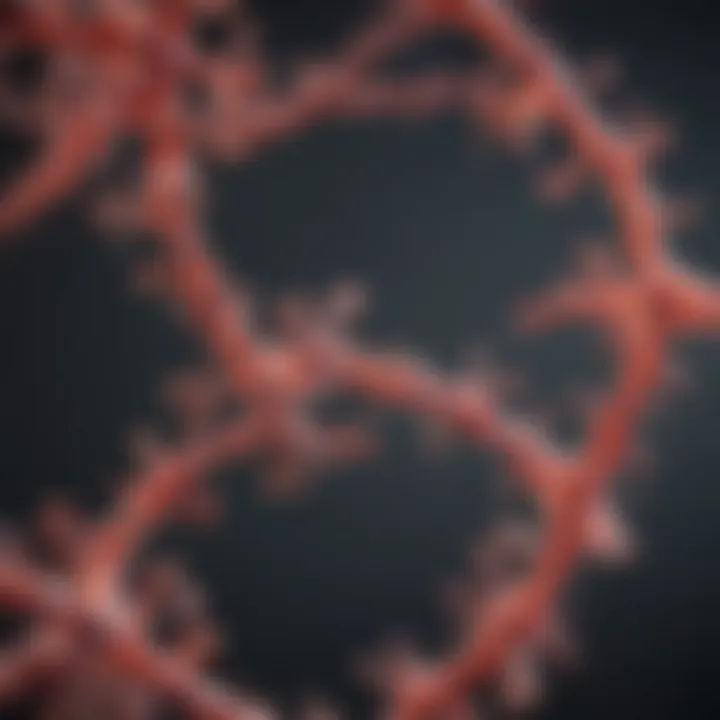The Intricacies of RNA Sequencing Explained


Intro
RNA sequencing has fundamentally changed how researchers study gene expression and genome complexity. This method allows scientists to quantify and analyze RNA within a biological sample, revealing insights that are crucial for understanding cellular processes. This exploration aims to clarify the RNA sequencing process, detailing its critical components and advancements. By shedding light on sample preparation, methodologies, and the latest technologies, we provide a roadmap for students, researchers, educators, and professionals seeking deeper knowledge in this pivotal area of molecular biology.
Recent Advances
Latest Discoveries
Recent studies have highlighted significant discoveries made possible by RNA sequencing. One notable advancement involves the identification of novel non-coding RNAs, which play essential roles in regulating gene expression. These molecules were previously overlooked, but their involvement in various biological functions and disease states has become evident.
The ability to profile hundreds of thousands of transcripts in a single experiment has also expanded our understanding of cellular responses. This capability has been instrumental in studies related to cancer biology, where researchers investigate how tumor cells communicate and behave under different conditions.
Technological Innovations
The field of RNA sequencing has seen rapid technological developments. High-throughput sequencing technologies from companies like Illumina and Pacific Biosciences have enabled scientists to obtain vast amounts of data quickly and accurately. These innovations make it possible to sequence entire transcriptomes at a fraction of the previous time and cost.
Moreover, advancements in bioinformatics tools have allowed for better data analysis. Software programs can now manage and interpret the complexity of RNA sequencing data efficiently. This improvement enables researchers to focus on biological interpretations rather than merely handling data.
Methodology
Research Design
The design of RNA sequencing experiments can vary based on the biological question at hand. Typically, a clear hypothesis guides the selection of experimental conditions, sample types, and controls. Understanding factors such as the type of tissue, developmental stage, and environmental conditions is essential for obtaining meaningful results.
Data Collection Techniques
The data collection process comprises several steps:
- Sample Preparation: Biological samples are collected and processed to extract RNA. This step is crucial as the quality of RNA affects the results.
- Library Construction: Extracted RNA is converted into complementary DNA (cDNA) and prepared for sequencing. This step includes fragmenting the cDNA and adding specific adapters.
- Sequencing: The prepared library undergoes sequencing using high-throughput methods. This phase generates the raw data needed for analysis.
- Data Analysis: Subsequent bioinformatics analysis involves aligning the sequences to a reference genome, quantifying expression levels, and identifying differentially expressed genes.
"Understanding the complexities of RNA sequencing enhances our knowledge of genomics and provides a path for future medical innovations."
With each of these stages carefully executed, RNA sequencing provides genomic insights that were previously unattainable. As techniques continue to evolve, they hold great promise for unlocking new biological pathways and diagnosing diseases more effectively.
Prologue to RNA Sequencing
RNA sequencing is an essential technique in molecular biology, providing insights into gene expression and understanding the complexities of genomes. This technique allows researchers to quantify RNA in a sample, revealing how genes are expressed under various conditions. The growing significance of RNA sequencing is evident in its applications across various fields such as biomedical research, diagnostics, and personalized medicine.
The importance of RNA sequencing lies in its ability to facilitate the exploration of RNA molecules, which play critical roles in various biological processes. By studying RNA, scientists can gain insights into cellular functions and investigate disruptions that may lead to diseases.
Definition of RNA Sequencing
RNA sequencing, often referred to as RNA-Seq, is a powerful technology that enables the study of transcriptomes. It involves capturing and sequencing complementary DNA (cDNA) that is synthesized from RNA samples, allowing researchers to analyze gene expression patterns comprehensively. Unlike traditional methods, RNA sequencing provides a global view, capturing the entire transcriptome instead of focusing on specific genes. This approach enables the detection of novel transcripts, alternative splicing events, and non-coding RNA, providing a more accurate picture of gene activity.
Historical Context
The journey of RNA sequencing began in the early 2000s with the advent of high-throughput sequencing technologies. Prior to RNA-Seq, researchers relied heavily on microarrays to study gene expression. However, microarrays had limitations, such as their inability to capture low-abundance transcripts and their reliance on pre-defined probes.
The introduction of next-generation sequencing technologies marked a significant shift. The first RNA-Seq publications emerged around 2008, showcasing its potential to outperform traditional methods. Over time, improvements in sequencing technologies, such as increased throughput and reduced costs, have made RNA sequencing a standard tool in the genomics field. Today, RNA sequencing has become indispensable for understanding gene function, cellular responses to environmental changes, and the molecular basis of diseases.
"RNA sequencing opens a window into gene expression, allowing researchers to explore the complex dynamics of cellular activity."
Fundamentals of RNA
RNA, or ribonucleic acid, plays a critical role in the realm of molecular biology. Its significance extends from fundamental cellular processes to intricate regulatory mechanisms. Understanding the various types of RNA and their specific functions is essential for comprehending how genes are expressed and regulated. This article will delve into the different classes of RNA, which include messenger RNA (mRNA), transfer RNA (tRNA), ribosomal RNA (rRNA), and non-coding RNA. Each of these types serves unique and pivotal roles that impact gene expression and cellular functions. Furthermore, the current knowledge of RNA’s functionality enriches the interpretation of RNA sequencing outcomes, making it a vital area of study in molecular biology.
Types of RNA
mRNA
Messenger RNA is arguably the most well-known type of RNA and serves as a template for protein synthesis. Its primary role is to convey genetic information from DNA to ribosomes, where proteins are synthesized. The key characteristic of mRNA is its ability to carry codons, sequences of three nucleotides that correspond to specific amino acids. This function makes mRNA a beneficial choice for studying gene expression patterns. A unique feature of mRNA is its poly(A) tail, which enhances stability and aids in translation efficiency. However, mRNA can also be subject to degradation, which might limit its detection in specific conditions.
tRNA
Transfer RNA plays a crucial role in the translation process, facilitating the translation of mRNA into polypeptide chains. Each tRNA molecule carries a specific amino acid and recognizes the corresponding codon on the mRNA through its anticodon. The key characteristic of tRNA is its cloverleaf structure, which enables the correct positioning of the amino acids during protein synthesis. This structural configuration makes tRNA an essential component of translation. A unique advantage of tRNA is its adaptability; multiple tRNA variants exist for the same amino acid, allowing for efficient protein synthesis. Nonetheless, tRNA’s involvement is less emphasized in RNA sequencing studies compared to mRNA.
rRNA
Ribosomal RNA is the primary structural component of ribosomes, the cellular machinery responsible for protein synthesis. It accounts for a significant proportion of total RNA within the cell. The key characteristic of rRNA is its ability to catalyze peptide bond formation during translation, which makes it integral to the ribosome's functioning. The unique feature of rRNA is its highly conserved nature across species, which provides insights into evolutionary relationships. However, the focus on rRNA in sequencing efforts can present challenges in distinguishing between different ribosomal RNA types, which might complicate data interpretation.
Non-coding RNA
Non-coding RNAs comprise a diverse group of RNA molecules that do not code for proteins but play significant regulatory roles. This category includes microRNA and long non-coding RNA, which are involved in gene regulation and chromatin remodeling. The key characteristic of non-coding RNA is its ability to modulate gene expression post-transcriptionally, often through interactions with mRNA or chromatin. These unique features provide powerful avenues for research, especially in understanding complex regulatory networks in cells. Despite their importance, non-coding RNAs can be challenging to study due to their varied expression patterns and functions.
Role of RNA in the Cell
RNA serves as a versatile molecule within biological systems. Its primary functions encompass encoding genetic information, facilitating translation, and regulating gene expression. The interplay between different RNA types enriches our understanding of cellular management and gene regulation, providing a fundamental foundation for RNA sequencing techniques. This broad role highlights the necessity of investigating RNA’s mechanisms in greater detail, paving the way for advanced research in genetics and molecular biology.
"RNA is not just a passive messenger; it actively influences cellular pathways, making it a key figure in biology."
The study of RNA types and their functions is critical for appreciating the complexities of molecular biology and the interpretational frameworks employed in RNA sequencing.
Sample Preparation
Sample preparation is a crucial step in RNA sequencing, as it directly influences the quality and reliability of the data generated. The accuracy of subsequent analyses relies heavily on the integrity and purity of the RNA extracted from biological samples. Proper sample preparation ensures that real biological signals are captured, minimizing artifacts that can arise during later stages of sequencing. Many factors can affect RNA quality, including the methods used for RNA isolation and the specific conditions under which samples are handled. Therefore, understanding and optimizing the sample preparation stage is essential for successful RNA sequencing.
Isolation of RNA


Mechanical Disruption
Mechanical disruption is an essential method for isolating RNA from cells and tissues. It involves physically breaking apart the samples using tools like grinders, bead mills, or homogenizers. This method is particularly effective in obtaining high yields of RNA from tough or fibrous samples, where other methods may fail. The key characteristic of mechanical disruption is its ability to produce an efficient homogenate, which is necessary for complete lysis of cells. Because of its efficiency, this method is often the preferred choice in laboratories that handle diverse and challenging sample types.
However, while mechanical disruption has advantages, it is not without drawbacks. The introduction of mechanical force can sometimes lead to RNA degradation, especially if not handled delicately. Moreover, this method requires specific equipment that may not be available in all laboratories, limiting access for some researchers.
Chemical Lysis
Chemical lysis is another widely used method for RNA isolation. This technique employs organic solvents and detergents to break down cell membranes and release RNA into a solution. The key feature of chemical lysis is its effectiveness in preserving RNA integrity during the extraction process. By using chemicals like phenol or guanidine thiocyanate, researchers can achieve high yield and purity of RNA, making it a beneficial method in situations where mechanical disruption is not suitable.
A unique aspect of chemical lysis is its adaptability to various sample types, including those that are softer or more sensitive to mechanical stress. However, this method can be less efficient in breaking down tough, fibrous tissues compared to mechanical methods. Additionally, researchers must be cautious with chemical handling and disposal, as some reagents can pose hazards if not managed properly.
Quality Assessment
Quality assessment of the extracted RNA is a vital step to ensure that the RNA is suitable for sequencing. This process typically includes several techniques aimed at evaluating the integrity and concentration of RNA.
RNA Integrity Number (RIN)
The RNA Integrity Number (RIN) provides a quantitative measure of RNA integrity, crucial for successful sequencing outcomes. RIN scores range from 1 to 10, where a score of 10 indicates pristine RNA. This characteristic makes RIN a beneficial choice, as it gives a clear, quantifiable indication of RNA quality. The use of RIN helps researchers decide whether a sample is suitable for sequencing or if further purification is necessary.
A notable advantage of RIN is its ability to offer insights into the potential performance of RNA in downstream applications, linking RNA quality with the reliability of gene expression data. However, RIN values could vary across different RNA types, which may require further context during interpretation.
Spectrophotometric Analysis
Spectrophotometric analysis is a classic technique used to assess RNA quality and concentration. It relies on measuring absorbance at specific wavelengths, allowing researchers to determine the purity and concentration of RNA in a sample. A common characteristic of spectrophotometric analysis is its speed and ease of use, making it a popular choice in various laboratories.
This method can provide rapid results, allowing for efficient processing of many samples. However, it also has limitations. Spectrophotometric analysis can yield misleading results, especially if proteins or contaminants are present, affecting the absorbance readings. Thus, it is often used in conjunction with other quality assessment methods to ensure comprehensive evaluation.
Library Construction
Library construction is a crucial phase in the RNA sequencing process. It involves the preparation of RNA samples for sequencing, transforming them into "libraries" that can be read by sequencing machines. This step allows for the analysis of gene expression and enables researchers to obtain comprehensive insights into the transcriptome. The quality and efficiency of library construction directly affect the outcomes of RNA sequencing. Key elements of library construction include cDNA synthesis and adapter ligation.
cDNA Synthesis
Reverse Transcription
Reverse transcription is the first step in cDNA synthesis. It converts RNA into complementary DNA (cDNA) using the enzyme reverse transcriptase. This process helps to create a stable and suitable form of the RNA for sequencing. One notable characteristic of reverse transcription is its ability to preserve the structural integrity of the original RNA. It is favored because it allows researchers to analyze RNA that otherwise would only degrade in standard conditions.
Advantages of reverse transcription include:
- High sensitivity, allowing the detection of low-abundance transcripts.
- Versatility in working with various RNA types, such as mRNA or non-coding RNA.
Potential disadvantages may involve:
- Variability in enzyme efficiency, which can lead to amplifications biases.
Amplification Techniques
Amplification techniques are used after cDNA synthesis to ensure that there is enough material for sequencing. Techniques such as PCR (Polymerase Chain Reaction) enable selective amplification of specific cDNA fragments. The key characteristic of amplification techniques is their ability to increase the quantity of nucleic acids from minuscule amounts of starting material. This feature makes amplification techniques essential for RNA sequencing as it ensures sufficient material for the next steps.
Benefits of amplification techniques involve:
- Increasing the sensitivity of the sequencing process.
- Allowing for specific targeting of transcripts, which can provide more detailed data.
However, drawbacks may include:
- Risk of introducing errors during amplification, which can affect data quality.
Adapter Ligation
Adapter ligation is the final step in the library construction phase. It involves attaching specific sequences, called adapters, to both ends of the cDNA fragments. These adapters are essential for several reasons. They enable the fragments to be recognized and amplified during the sequencing process. Furthermore, adapters allow for barcode inclusion, which helps in multiplexing—sequencing multiple samples in the same run, thus optimizing time and cost.
Despite the advantages, adapter ligation also presents challenges. Proper ligation efficiency is crucial; poor ligation can result in reduced sequencing output and quality. Overall, successful library construction underpins the efficacy of RNA sequencing, supporting accurate gene expression analysis and contributing to extensive research in molecular biology.
Sequencing Techniques
Sequencing techniques are crucial for understanding RNA sequencing. They determine the resolution, accuracy, and depth of the data obtained. Such techniques lay the groundwork for how we analyze gene expression and identify variations within complex genomes. With RNA sequencing, choosing the appropriate sequencing technique can impact the insight one gains from the analysis.
Next-Generation Sequencing (NGS)
Illumina Sequencing
Illumina sequencing is a widely adopted technique due to its high throughput and accuracy. A key characteristic of Illumina is its ability to generate millions of short reads simultaneously. This feature enhances the depth of coverage, allowing researchers to detect rare transcripts or isoforms. On a practical level, this makes it a favorable choice for researchers working on various biological questions.
The unique feature of Illumina sequencing lies in its sequencing by synthesis approach. This method employs fluorescently labeled nucleotides, enabling real-time monitoring of DNA incorporation. The main advantages include cost-effectiveness and scalability.
Despite its benefits, Illumina sequencing also has limitations. One disadvantage is that its short read length can make assembly difficult, particularly in the context of complex genomes with high repetitive elements.
Sequencing
454 sequencing was known for its ability to produce longer reads compared to other platforms. This characteristic played a vital role in applications requiring greater contiguity, such as de novo transcriptome assembly. 454 technology uses pyrosequencing, which detects light produced during nucleotide incorporation. This capability brings a different perspective to RNA sequencing tasks.
The primary advantage of 454 sequencing is its read length. Longer reads facilitate improved mapping to genomes and alleviate some challenges of short-read sequencing. However, one should consider the limitations too. 454 sequencing has a higher cost per base, restricting its widespread application, especially in large-scale projects.
Single-Cell RNA Sequencing
Single-cell RNA sequencing represents a groundbreaking shift in analyzing gene expression at the single-cell level. By allowing researchers to study RNA profiles of individual cells, this technique captures cellular heterogeneity that bulk RNA sequencing often masks. This level of detail is indispensable for understanding complex biological systems, such as tissue development and disease progression.
Single-cell RNA sequencing employs various methodologies to achieve high sensitivity and accuracy, enabling deep insights into gene expression dynamics. Through this approach, it is possible to reveal pathways that contribute to specific behaviors of cells in different biological contexts.


Overall, sequencing techniques are foundational in RNA sequencing, shaping our understanding of gene expression and aiding in discoveries across multiple scientific domains.
Data Processing
Data processing in RNA sequencing is an essential stage. It involves several steps that transform raw sequencing data into insightful genomic information. This segment is crucial not only for ensuring the accuracy of the findings but also for maximizing the potential of RNA sequencing technologies. The importance of data processing cannot be understated. Without proper data handling, the insights from RNA sequencing can be misleading, if not entirely erroneous.
Quality Control of Sequencing Data
Effective quality control is crucial in analyzing sequencing data. This process ensures that the data you work with is reliable and high-quality, which in turn enhances the validity of the conclusions drawn from the results.
Filtering Low-Quality Reads
Filtering low-quality reads is an initial step in quality control. This aspect focuses on removing sequences that do not meet specific quality thresholds. The contribution of filtering low-quality reads to the overall goal of RNA sequencing is significant; it helps maintain data integrity. Biological interpretations rely heavily on the accuracy of the underlying data.
A key characteristic of this method is its ability to decrease the noise that manifests in sequencing outputs. This method is popular because it prevents erroneous data points from skewing results, which can be vital for accurate gene expression analysis. The unique feature of filtering low-quality reads is its automation, allowing researchers to utilize software such as FastQC or Trimmomatic for analysis. While this method is remarkably effective, it can sometimes lead to loss of valuable data if not executed with care. Hence, understanding the thresholds and parameters for filtering is important to retain useful information.
Trimming Adapter Contaminations
Trimming adapter contaminations targets the removal of unwanted sequences that come from the sequencing process. Often during the RNA-sequencing process, short sequences or adapters are added, but they can interfere with data interpretation. Trimming these contaminants allows for cleaner reads, which significantly aids downstream analysis.
Just like filtering low-quality reads, trimming adapter contaminations supports the accuracy of the final dataset. This method is beneficial in maintaining the quality of transcripts being assessed. The key characteristic of this technique lies in its specificity; it closely targets non-biological sequences added during library preparation. The use of tools such as Cutadapt makes this process efficient. However, a disadvantage is the potential to remove legitimate sequences if contamination patterns are not well understood.
Alignment and Mapping
Alignment and mapping represent a pivotal phase in data processing. This step involves matching RNA sequences against a reference genome or transcriptome. Accurate alignment is vital for quantifying gene expression, identifying novel transcripts, and discovering genetic variants.
Genome Alignment Tools
Genome alignment tools such as STAR and HISAT2 are designed for this critical task. Their primary function is to align sequencing reads to a reference genome. The main advantage of using such tools is their speed and accuracy in mapping even large datasets. They incorporate sophisticated algorithms to manage complexities in sequencing data, such as splice variants in eukaryotic genomes.
A unique feature is these tools' ability to handle large-scale data efficiently, which is essential given the increasing volume of RNA-seq data generated today. However, dependence on these tools requires consideration of computational resources, which can be substantial.
Transcriptome Assembly
Transcriptome assembly is another essential aspect of alignment and mapping. This process organizes RNA sequences into full transcripts, which may involve piecing together fragments of genes originating from different reads. This can lead to a comprehensive picture of gene expression within a studied sample.
The key characteristic of transcriptome assembly is its focus on reconstructing full-length transcripts from fragmented reads, which enhances the understanding of alternative splicing events. Assemblers like StringTie are widely used in this context, making it a popular choice for researchers aiming for in-depth gene expression analysis.
However, transcriptome assembly can create challenges. The process may produce ambiguities in cases where similar gene sequences exist, leading to issues in accurately quantifying expression levels for closely related transcripts.
In summary, data processing is a foundational aspect of RNA sequencing. Quality control, alignment, and mapping are all significant components that contribute to reliable and valid research outcomes.
Gene Expression Analysis
Gene expression analysis is central to understanding the function of genes in various biological processes. This section delves into the methodologies used to quantify the expression levels of RNA transcripts and to compare differences across different conditions or treatments. By examining gene expression, researchers can gain insights into how genes are regulated, how they interact with each other, and how they contribute to phenotypic variations.
Understanding gene expression is crucial for several reasons. First, it sheds light on cellular responses to environmental changes. For instance, if a cell undergoes stress, certain genes will be activated or repressed accordingly. Second, gene expression analysis aids in identifying biomarkers for diseases. For example, in cancer research, specific gene expression patterns can indicate the presence of tumors or predict treatment responses. Lastly, understanding gene regulation can inform therapeutic strategies, especially in personalized medicine.
Quantification of Transcripts
To analyze gene expression accurately, quantifying transcript levels is necessary. This is often done using techniques such as quantitative PCR (qPCR) or RNA sequencing itself. The quantification process involves comparing the abundance of specific mRNA molecules in different samples. This comparative analysis allows researchers to determine which genes are upregulated or downregulated in specific conditions.
Achieving accurate quantification requires methodologies that minimize errors. Normalization against housekeeping genes is commonly employed to account for variations in total RNA input and experimental conditions. This adjustment provides a more accurate reflection of true gene expression.
Differential Expression Analysis
Proceeding to differential expression analysis, this method identifies genes whose expression levels differ significantly between defined conditions. It is a fundamental aspect of interpreting RNA sequencing data and helps researchers understand the biological significance behind the observed variations.
Statistical Approaches
Statistical approaches in differential expression analysis play a vital role. Many researchers rely on tools such as DESeq2 and EdgeR, which use negative binomial distribution models to analyze count data from RNA sequencing. These statistical methods account for variability and ensure robust conclusions about gene expression changes across different conditions.
One key characteristic of these statistical approaches is their ability to handle small sample sizes while controlling for false discovery rates. This makes them beneficial, particularly in early-stage research where sample collection can be limited.
However, a unique feature of these approaches is their dependency on the quality of the input data. High-quality sequencing data is essential for reliable conclusions. When poorly quality data is included, it could lead to false positives or negatives, affecting the overall outcome of the study.
Visualization Techniques
Visualization techniques are also integral to the interpretation of differential expression results. Common methods include heatmaps and volcano plots, which visually represent the magnitude and direction of gene expression changes.
These techniques are beneficial because they allow researchers to identify patterns or clusters of genes that behave similarly across different conditions. They provide an intuitive way to grasp complex data and facilitate discussions and presentations among researchers.
However, one should be cautious about overinterpreting these visualizations. While they are powerful, they can sometimes obscure underlying complexities in the data. Therefore, they should always be complemented with rigorous statistical analysis for validation.
"Gene expression analysis combines both quantitative precision and visual representation to facilitate a deeper understanding of cellular processes."
In summary, gene expression analysis offers a comprehensive view of gene function and regulation. By quantifying transcripts, implementing rigorous statistical methods, and employing effective visualization techniques, researchers can harness the full power of RNA sequencing to advance knowledge in various biological fields.
Applications of RNA Sequencing
RNA sequencing serves as a powerful tool in modern molecular biology. Its diverse applications not only enhance our understanding of biology but also open new avenues for medical diagnostics and treatment. Each application highlights specific benefits and considerations, making it essential for ongoing research in various fields.
Disease Diagnostics
RNA sequencing has transformed the landscape of disease diagnostics. By analyzing the RNA profile of cells, researchers can identify specific gene expression changes associated with particular diseases. This is especially valuable in cancer diagnostics, where tumor profiles can reveal mutations and aberrant expression patterns.
For example, targeted RNA sequencing methods can pinpoint fusion genes unique to certain cancer types, aiding in the early detection and personalized treatment options.


Benefits of RNA sequencing in disease diagnostics include:
- Early Detection: Allows for identification of diseases before symptoms appear.
- Precision Medicine: Enables tailored treatment plans based on individual gene expression.
- Comprehensive Data: Provides insights into the tumor microenvironment, cancer evolution, and potential therapeutics.
Understanding Developmental Biology
RNA sequencing plays a role in developmental biology, influencing how we understand organism development at the molecular level. By studying RNA profiles during different developmental stages, scientists can uncover regulatory networks that govern cell fate decisions.
This technique enables comparative studies among species, highlighting how gene expression drives evolution. For instance, the study of embryonic development in model organisms can reveal conserved pathways crucial for forming complex tissues and organs.
Key insights from RNA sequencing in developmental biology include:
- Gene Regulation: Revealing how genes are turned on and off during development.
- Cell Lineage: Understanding how different cell types emerge from a single progenitor.
- Comparative Analysis: Assessing evolutionary changes in gene expression across species.
Pharmacogenomics
Pharmacogenomics examines how genetic variations influence an individual's response to drugs. RNA sequencing is essential in this field, providing insights into how gene expression affects drug metabolism and efficacy. It allows for the identification of biomarkers that predict therapeutic responses, minimizing adverse drug reactions.
This application is particularly relevant in oncology, where RNA sequencing can guide chemotherapy regimens based on tumor profiles. Tailoring treatments based on individual genetic makeup enhances treatment effectiveness while reducing harmful side effects.
Main contributions of RNA sequencing to pharmacogenomics include:
- Biomarker Discovery: Identifying genetic predictors of drug response.
- Treatment Optimization: Helping to select appropriate therapies for individuals based on RNA expression data.
- Adverse Effect Reduction: Lowering the incidence of negative side effects through personalized medicine.
RNA sequencing is not just about sequencing. It’s about understanding complexities within biology and translating that knowing into practical applications across various fields.
Challenges in RNA Sequencing
RNA sequencing, despite its numerous advantages, is not without its challenges. Understanding these obstacles is essential for advancing both the methodology and the applications of RNA sequencing in research. The following sections will explore the technical limitations inherent to RNA sequencing processes as well as the issues related to data interpretation.
Technical Limitations
RNA sequencing faces several technical limitations that can affect the reliability of the results. One major challenge is the heterogeneity of RNA molecules. Different types of RNA can have varying abundances, sizes, and stability. This variability can lead to inconsistent data if not appropriately managed.
Another significant limitation is the quality of RNA samples. Degradation can occur due to improper handling or storage, leading to a loss of important information about gene expression. This means that the quality assessment of RNA samples becomes critical. Researchers must implement stringent quality control measures from the moment of RNA isolation until sequencing.
Additionally, sequencing depth is another technical concern. Not every transcript is represented equally in the data due to biases in the sequencing process itself, which can result in missed or inaccurate representations of low-abundance transcripts. Hence, determining an adequate coverage and sequencing depth is vital for experimental design.
Some other minority challenges include:
- Amplification artifacts, which may create misleading data during cDNA synthesis.
- Adapter contamination, which can interfere with downstream analysis if not trimmed properly.
- Limited read length in some sequencing technologies, which can pose difficulties in reconstructing longer transcripts or isoforms.
Data Interpretation Issues
The interpretation of RNA sequencing data presents its own set of challenges that can impact the conclusions drawn from experiments. One key issue is the complexity of gene expression analysis. Given that multiple factors influence RNA levels, it is difficult to attribute changes to specific genetic or environmental causes without comprehensive experimentation.
Gene expression can vary due to biological variability among samples or even across different conditions of the same sample. This adds another layer of complexity in determining differential expression. Using appropriate statistical methods is crucial to accurately analyze the data and minimize false positives or negatives in the results.
Moreover, the abundance of bioinformatics tools available can also induce confusion among researchers. Choosing the right software to analyze RNA sequencing data requires in-depth knowledge, and incorrect choices may yield misleading results. Users often face a learning curve associated with many tools, which can hinder progress in projects.
Furthermore, the integration of data from different platforms can introduce inconsistency, leading to challenges in cross-study comparisons. Researchers should apply standardized methods and pipeline practices to enhance reproducibility and reliability of the findings.
In RNA sequencing, understanding technical limitations and data interpretation issues is critical in ensuring robust results.
In summary, while RNA sequencing has revolutionized molecular biology, recognizing its challenges allows for improved methodologies and more reliable data analysis, ultimately benefiting research across various scientific fields.
Future Directions in RNA Sequencing
RNA sequencing continues to evolve, presenting a multitude of opportunities to expand our understanding of genomics. This section explores significant technological advancements and broader applications that illustrate the future landscape of RNA sequencing. These directions promise to enhance precision, reduce costs, and increase the applicability of RNA-seq in various research areas.
Technological Advancements
Advancements in technology play a crucial role in the progress of RNA sequencing. New platforms are emerging that enhance sequencing speed and accuracy. Here are some key elements driving these advancements:
- Improved Sequencing Platforms: Technologies such as Oxford Nanopore and PacBio SMRT sequencing are enabling long-read capabilities, allowing researchers to explore complex genomes more effectively.
- Enhanced Data Processing Tools: With the rise of sophisticated bioinformatics tools, the challenge of data analysis becomes manageable. Software such as STAR and HISAT2 streamline alignment tasks, allowing for quicker analysis.
- Integration of Machine Learning: Machine learning algorithms are being applied to predict gene function and expression levels. This automated approach can reveal patterns in large datasets that were previously hidden.
- Portable Sequencing Technologies: Devices like the MinION provide the means for real-time sequencing in a field setting. This capability opens doors for applications in diverse environments, from clinical settings to environmental studies.
These advancements continue to bridge gaps in current methodologies, making RNA sequencing more accessible to a broader audience.
Broader Applications Across Sciences
As RNA sequencing technology matures, its applications extend well beyond traditional molecular biology. Here’s a look at several domains where RNA sequencing is making an impact:
- Cancer Research: RNA sequencing is vital in identifying biomarkers and characterizing tumor heterogeneity, aiding in the evolution of personalized medicine. This approach allows for tailored therapies based on individual genetic profiles.
- Neuroscience: Insights into gene expression in the brain can unveil mechanisms of neurological disorders. Single-cell RNA sequencing enables researchers to investigate cellular diversity in neural tissues.
- Environmental Biology: RNA sequencing helps in understanding the response of organisms to environmental changes. It enhances our comprehension of ecosystem dynamics.
- Agricultural Sciences: In crop research, RNA sequencing aids in the identification of traits related to disease resistance and yield improvement.
- Microbiome Studies: Analyzing the RNA from microbiomes provides a view of microbial dynamics and their roles in health and disease.
RNA sequencing is fostering interdisciplinary collaborations, driving innovation across various scientific fields.
In summary, the future of RNA sequencing holds immense potential. With technological advancements that enhance capabilities and diverse applications across scientific disciplines, RNA sequencing is poised to deliver significant contributions to research and health sciences.
Ending
The conclusion of this article serves as a concise summary, weaving together the intricate details discussed throughout the sections. It is pivotal in reinforcing the importance of RNA sequencing, emphasizing its role in modern molecular biology. RNA sequencing is not merely a technical procedure; it plays a crucial part in unraveling complex biological systems and enhancing our understanding of gene function. The implications are vast, impacting fields such as genetics, medicine, and evolutionary biology.
Summary of Key Points
- Importance of RNA Sequencing: This process has revolutionized how scientists study gene expression, providing insights that were previously unattainable.
- Steps Involved: The journey from sample preparation, through library construction, sequencing, and data analysis, is methodical and requires precision.
- Applications: RNA sequencing has applications in disease diagnostics, development studies, and pharmacogenomics, underlining its versatility.
- Challenges and Future Directions: While there are technical limitations and data interpretation hurdles, the technological advancements in RNA sequencing promise broader applications in various sciences.
Final Thoughts on RNA Sequencing
In closing, RNA sequencing stands out as a paramount tool in genomics. Its evolution has provided researchers with powerful methods to analyze RNA and understand gene regulation. As this technology continues to advance, it holds the potential not just to enhance our fundamental biological understanding but also to contribute significantly to precision medicine. The future of RNA sequencing looks bright, with emerging technologies promising to make this method even more accessible and informative.
"RNA sequencing is more than just a technique; it is a bridge to new discoveries in biology and medicine."
For ongoing updates and discussions about RNA sequnecing, interested individuals can explore relevant forums on platforms like Reddit or consult articles on Wikipedia.
In summary, RNA sequencing is essential for anyone engaged in biological research, clinical diagnostics, or genomics, and it's clear that understanding its processes and implications is crucial for the future of these fields.















